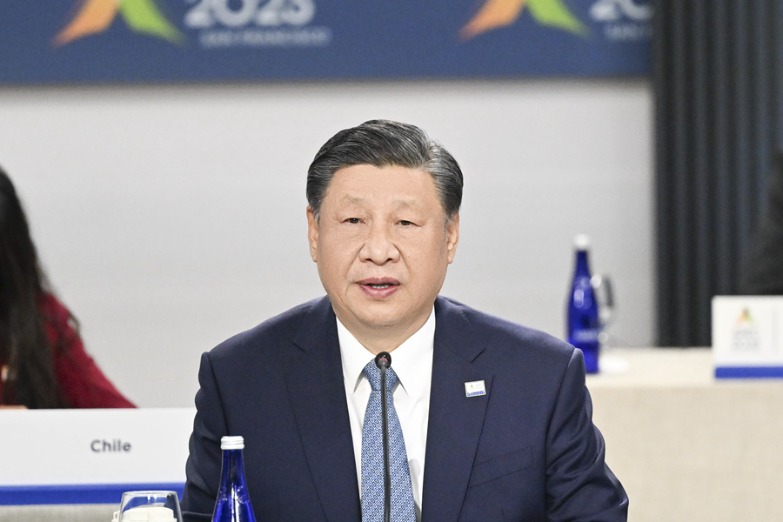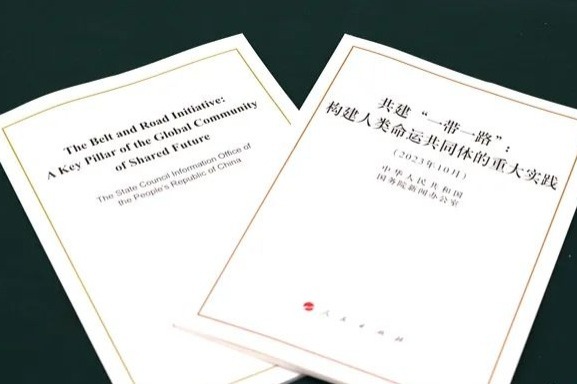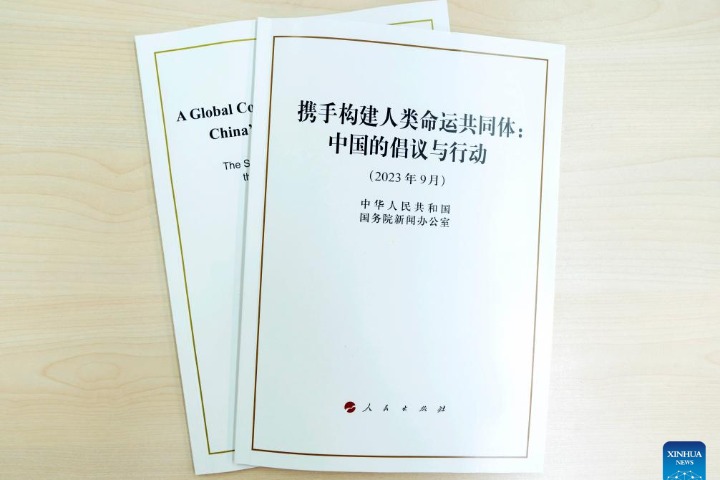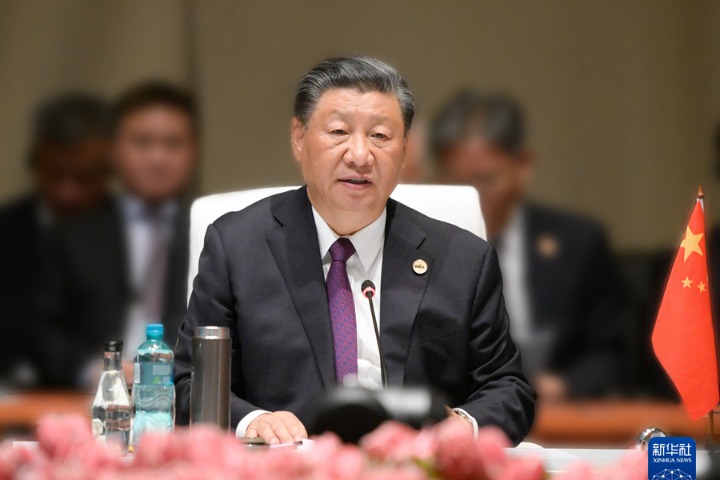《新疆的文化保护与发展》白皮书(双语全文)
新华网 2018-11-16 09:45

三、宗教文化受到尊重和保护
III. Respecting and Protecting Religious Culture
新疆历来是多种宗教并存地区,宗教文化丰富多样,是中国传统文化的组成部分。中国政府保障公民宗教信仰自由权利,尊重和保护宗教文化。
Since antiquity Xinjiang has seen the coexistence of a variety of religions, whose rich cultures have become part of traditional Chinese culture. China's government is committed to protecting its citizens' freedom of religious belief while respecting and protecting religious cultures.
多种宗教文化交融共存。新疆历来是多种宗教传播的重要地区,是宗教文化的汇聚之地。新疆最初流行原始宗教、萨满教。公元前4世纪起,随着祆教、佛教等相继传入,逐步形成多种宗教并存的格局。后来,道教、摩尼教、景教、伊斯兰教等先后传入,多种宗教并存的格局不断发展演变。一教或两教为主、多教并存是新疆宗教格局的历史特点。多种宗教文化长期交融共存,互相借鉴,并在适应中国社会发展过程中调整变化。目前,新疆有伊斯兰教、佛教、基督教、天主教、道教等。萨满教和祆教的元素遗留至今,并且以生活习俗的形式表现出来。佛教文化影响深远,在喀什、哈密、伊犁等地,仍可见到佛龛、莲花图案、莲花宝座等遗存。
Many religious cultures blend and coexist. Xinjiang has long been a region where multiple religions are practiced and their cultures have met and blended. Primitive religion and Shamanism were practiced in Xinjiang before Zoroastrianism, Buddhism and other faiths were introduced into the region from the 4th century BC onward. Gradually there came into being a network of coexisting religions. This network further evolved with the introduction of Taoism, Manichaeism, Nestorianism, and Islam. A coexistence of multiple religions, with one or two predominant, was a basic characteristic of Xinjiang's religious history. During their lengthy coexistence and interaction, the religious cultures in the region learned from one another and adapted to China's social development. At present, the major religions in Xinjiang are Islam, Buddhism, Protestant and Catholic Christianity, and Taoism. Certain Shamanistic and Zoroastrian elements can still be observed in local customs today. The remains of Buddha niches, lotus patterns, and lotus seat sculptures in Kashgar, Hami, and Ili testify to the once widespread influence of Buddhism in the region.
宗教典籍文献依法出版发行。国家以多种语言文字翻译出版发行伊斯兰教、佛教、基督教等宗教典籍文献,满足各族信教公民的多样化需求。新疆已翻译出版发行汉、维吾尔、哈萨克、柯尔克孜等多种文字的《古兰经》《布哈里圣训实录精华》等宗教经典书籍,编辑发行汉、维吾尔两种文字的《卧尔兹演讲集》系列。开办汉、维吾尔两种语言文字的新疆穆斯林网站。整理出版《金光明经卷二》《弥勒会见记》等宗教古籍文献。在专营宗教书刊的销售点,可以购买《古兰经》《圣经》《金光明经》等各种宗教典籍。
Religious texts are published and distributed in accordance with the law. The state has translated, published and distributed Islamic, Buddhist, Protestant, and other religious texts to meet the diverse demand of religious believers. The Koran and Irshad al-Sari li Sharh Sahih al-Bukhari have been published in Chinese, Uygur, Kazak and Kirgiz languages. The New Collection of al-Wa'z Speeches series have been compiled and published in both Chinese and Uygur languages. A website (www.xjmuslim.com) available in both Chinese and Uygur languages was set up for Xinjiang's Muslim community. Ancient religious books, including Volume II of the Golden Light Sutra (Suvarnaprabhasa Sutra) and Maitrisimit Nom Bitig, have been published. Important scriptures such as the Koran, Bible, and Golden Light Sutra are available at stores specializing in selling religious publications.
宗教文化遗产得到有效保护。目前,新疆有喀什艾提尕尔清真寺、昭苏圣佑庙、克孜尔千佛洞等109处宗教文化古迹被列入全国重点文物保护单位和自治区级文物保护单位。其中,全国重点文物保护单位46处,自治区级文物保护单位63处。中央政府拨专款对列入国家和新疆文物保护单位的克孜尔千佛洞、柏孜克里克石窟、喀什艾提尕尔清真寺等进行修缮。新疆出资维修吐鲁番苏公塔、昭苏圣佑庙、乌鲁木齐红庙子道观等28处宗教建筑(场所)。涉及宗教的非物质文化遗产也得到了保护和传承。
Religious heritages are effectively protected. A total of 109 religious sites in Xinjiang, including Id Kah Mosque in Kashgar, Shengyou Lamasery in Zhaosu, and the Kizil Thousand-Buddha Caves have been designated as major cultural heritage sites under the protection of the autonomous region and the state. Among the 109 sites, 46 are key cultural heritage sites under the protection of the state and 63 are under the protection of the autonomous region. The central government has allocated special funds to renovate cultural heritage protection sites at the state and autonomous-region levels, including the Kizil Thousand-Buddha Caves, Bezkilik Grottoes, and Id Kah Mosque. Xinjiang has funded the repair of 28 religious venues, including the Emin Minaret in Turpan, Shengyou Lamasery in Zhaosu, and Red Temple (Taoist) in Urumqi. Elements of intangible cultural heritage relating to religion are also effectively protected and passed on.
坚持宗教中国化方向。同所在社会相适应是宗教生存发展的规律。在中华文化兼容并蓄、求同存异、和而不同思想影响下,佛教等外来宗教都经历了中国化、本土化过程。佛教传入新疆后,主动适应社会发展、融入主流文化,对新疆历史和文化产生了深远影响。伊斯兰教传入新疆后沿着中国化方向发展,经过长期与当地传统信仰和文化融合,逐渐成为中华文化的一部分,并表现出地域特征和民族特色。天主教的独立自主、自办教会,基督教的自传、自治、自养等,都为实现宗教中国化作出了积极努力。新疆坚持宗教中国化的历史传统,积极引导宗教与社会主义社会相适应,支持宗教界深入挖掘教义教规中有利于社会和谐、时代发展、健康文明的内容,对教义教规作出符合当代中国发展进步、符合中华优秀传统文化的阐释,引导各种宗教坚持中国化方向。
Religions adapt to China's realities. Adapting to local society is essential for the survival and development of any religion. With influence from such Chinese cultural traditions as being inclusive, seeking common ground while reserving differences, and pursuing harmony without uniformity, Buddhism and other foreign religions have all directed their efforts to localization after entering China. After Buddhism was introduced into Xinjiang, it has exerted a far-reaching influence on Xinjiang's history and culture through proactive adaptation to local social norms and integration into the mainstream culture. Through extended fusion with local faiths and traditions, Islam gradually became part of Chinese culture and developed distinct regional and local ethnic features. The Catholic Church's principles of independence and self-management of its religious affairs, and Protestantism's compliance with the principles of self-propagation, self-governance, and self-support facilitated their adaptation to conditions in China. Xinjiang upholds the tradition of religious localization and provides guidance to religions on adaptation to China's socialist system. Religious circles in Xinjiang are encouraged to promote social harmony and development as well as cultural progress with the aid of religious doctrines and rules, and elaborate on the doctrines and rules that contribute to China's development and conform to China's traditions.
四、文化遗产保护和传承取得成就
IV. Protecting and Carrying Forward Cultural Heritage
新疆文化遗产丰富。中央政府和新疆地方政府不断加强法制建设,推进文化遗产保护工作。《中华人民共和国文物保护法》和《中华人民共和国非物质文化遗产法》等法律法规对保护新疆各民族丰富多彩的文化遗产提供了重要法治保障。
Xinjiang is a region rich in cultural heritage. The central government and the local government of Xinjiang have made a continuous effort to strengthen the legal system for the protection of the region's cultural heritage. The Law of the People's Republic of China on the Protection of Cultural Relics and the Law of the People's Republic of China on Intangible Cultural Heritage provide important legal protection for the diverse cultural heritage of all ethnic groups in Xinjiang.
文物保护成果丰硕。目前,新疆有各级文物保护机构189个,文物保护网络基本建成。全面完成全国不可移动文物普查3次,可移动文物普查1次,文化遗产家底进一步摸清。截至2017年,新疆文物点9542处,其中世界文化遗产6处、全国重点文物保护单位113处、自治区级文物保护单位558处。文化文物系统现有博物馆93个(包括自治区博物馆和吐鲁番地区博物馆2个国家一级博物馆),馆藏文物45万件/套。
Protection of cultural heritage yields results. Xinjiang has formed a cultural heritage protection network comprising 189 institutions at all levels. The region has completed three surveys on fixed national cultural relics and one on movable national cultural relics, forming a comprehensive database. By the end of 2017 Xinjiang had 9,542 cultural heritage sites, of which six were World Heritage sites, 113 were key national sites, and 558 were at the autonomous-region level. Xinjiang's cultural heritage system contains 93 public museums, including two national first-grade museums - the Xinjiang Uygur Autonomous Region Museum and the Turpan Museum, with a collection of 450,000 items.
新疆历史文化名城名镇名村街区保护取得显著成效。确立国家级历史文化名城5座、历史文化名镇3个、历史文化名村4个、历史文化街区2个、中国传统村落17个、中国少数民族特色村寨22个。多年来,中国政府对高昌故城遗址、北庭故城遗址、惠远新老古城遗址等一大批文物古迹进行修缮保护,抢救性保护修复3000余件珍贵文物。
Xinjiang has made great headway in protecting its historical and cultural cities, towns, villages and localities. The region now has five cities, three towns, four villages, and two localities that have been recognized as state-level historical and cultural divisions, as well as 17 traditional Chinese villages and 22 ethnic-minority villages with cultural significance. Over the years, the Chinese government has supported the repair and conservation of many cultural heritage sites, such as the Gaochang Ancient City Ruins, Beiting Ancient City Ruins, and new and old Huiyuan Ancient City, while rescuing and restoring more than 3,000 rare cultural relics.
考古发掘成果中外瞩目。截至2017年,新疆民丰尼雅遗址、尉犁营盘墓地、若羌小河墓地、库车友谊路晋十六国砖室墓、巴里坤东黑沟遗址、吉木乃通天洞遗址等8项考古发掘项目先后被列入当年全国十大考古新发现,出土了“五星出东方利中国”锦护臂、“王侯合昏千秋万岁宜子孙”锦被等国宝级文物。
Archaeological findings attract wide attention. By the end of 2017 eight archaeological programs, including the Niya Ruins in Minfeng County, Yingpan Cemetery in Yuli County, Xiaohe Cemetery in Ruoqiang County, 3rd-4th century brick graves in Kucha County, Dongheigou Ruins in Barkol County, and the Tongtiandong Cave in Jeminay County, had been listed among the National Top 10 Archeological Discoveries of the Year. The arm protector with the inscriptions of "Five stars appear in the East, sign of Chinese victory over the Qiang" and the silk quilt with inscriptions of "Marriages between princes and dukes bring prosperity to their posterity" unearthed from the Niya Ruins are national treasures.
古籍保护力度加大。成立了新疆维吾尔自治区古籍整理出版规划领导小组及办公室、古籍保护中心、古籍修复中心,建立少数民族古籍特藏书库。2011年,新疆古籍保护中心启动第一次古籍普查工作,对重点、珍贵古籍的基本内容、破损情况和保存状况登记造册。之后又数次开展普查。截至2017年,完成古籍整理普查14980种。已收藏的古代典籍文献包括汉文字(汉文字、西夏文和契丹文等)、阿拉美文字(佉卢文、帕赫列维文、摩尼文和回鹘文等10多种)和婆罗米文字(梵文、焉耆-龟兹文、于阗文、吐蕃文等)三大系统,共19种语言、28种文字,内容涵盖政治、经济、社会、宗教、天文、数学、医学、艺术等领域。古籍整理数字化建设日益加强。
Protection of ancient books has been strengthened. Xinjiang has set up a leading group and office in charge of the classification and publishing of the autonomous region's ancient books, an ancient books preservation center, an ancient books restoration center, and a repository for ancient books and special collections of ethnic minorities. In 2011 the region's Ancient Books Preservation Center started its first survey of ancient books, registering important and rare volumes and recording their content, physical condition, and preservation requirements. This was the first of several such surveys.By the end the 2017 the center had examined 14,980 books. Ancient books in its collection are written in 19 languages and 28 scripts, and fall into three language families: The Chinese language family (Chinese, Tangut, and Khitan scripts), the Aramaic family (more than 10 scripts, including the Kharosthi, Pahlavi, Manichaean, and Huihu scripts), and the Brahmi family (Sanskrit, Tocharian, Khotanese, and Tubo scripts). These books cover a wide range of subjects, including politics, the economy, society, religions, astronomy, mathematics, medicine, and the arts. Digitalization of ancient books and related work are further strengthened.
中国政府支持新疆以汉文和维吾尔文翻译、整理、出版了濒于失传的《福乐智慧》和《突厥语大词典》等古籍。组织古籍专家开展学术研究、提供咨询服务,邀请国内外古籍保护工作者、研究者和管理者交流研讨。2011年,国家文化部和新疆维吾尔自治区人民政府共同主办“西域遗珍——新疆历史文献暨古籍保护成果展”,其中孤本古籍超过半数,受到社会各界称赞。
The Chinese government has supported the translation, editing and publishing into Chinese and Uygur languages of Kutadgu Bilig (Wisdom of Fortune and Joy) and A Comprehensive Turki Dictionary, two works of the Karahan Kingdom period in the 11th century. The government has also organized experts in ancient books to carry out research and provide expertise in this field, and helped to arrange exchanges between Chinese and foreign professionals, researchers, and administrators engaged in the preservation of ancient books.In 2011 the Ministry of Culture and the local government of Xinjiang co-hosted an exhibition, titled "Recovered Treasures from the Western Regions: Progress in Preserving Xinjiang's Historical Literature and Ancient Books". More than half of the ancient books displayed at the exhibition were the only copies extant. This achievement was acclaimed by the widest range of interested parties.
非物质文化遗产得到有效保护。按照“保护为主、抢救第一、合理利用、传承发展”的原则,加强政策立法。2008年,新疆出台《新疆维吾尔自治区非物质文化遗产保护条例》;2010年,《新疆维吾尔自治区维吾尔木卡姆艺术保护条例》颁布实施。新疆出台一系列非物质文化遗产保护制度,为科学、系统地抢救保护非物质文化遗产提供了制度保障。
Intangible cultural heritage is effectively protected. Under the guiding principle of giving priority to both preservation and restoration, and pursuing sound utilization and development, the policy and legislation for protecting intangible cultural heritage have been strengthened. In 2008 the Regulations of the Xinjiang Uygur Autonomous Region on the Protection of Intangible Cultural Heritage were enacted. In 2010 the Regulations of the Xinjiang Uygur Autonomous Region on the Protection of Uygur Muqam Arts were promulgated and put into force. In addition, Xinjiang has introduced a number of rules for protecting its intangible cultural heritage, which provide institutional guarantees for rescuing and preserving this heritage in a coordinated and systematic manner.
中国政府1951年、1954年两次抢救性录制维吾尔十二木卡姆。上世纪60年代开始,投入大量资金和人力,整理出版了包括柯尔克孜族史诗《玛纳斯》、蒙古族史诗《江格尔》等多种民间口头文学作品。编纂出版《中国民族民间舞蹈集成·新疆卷》《中国民间歌曲集成·新疆卷》《中国民间故事集成·新疆卷》等涵盖各民族音乐、舞蹈、戏曲等门类的十大艺术集成志书。“中华文脉——新疆非物质文化遗产保护记录工程”持续实施。截至2017年,新疆完成23位国家级代表性传承人抢救性记录工作,运用文字、图片、音像等多种记录手段,对非物质文化遗产项目实施了抢救性保护;创建了维吾尔族乐器、地毯和艾德莱斯绸织造3个非物质文化遗产项目国家级生产性保护示范基地;命名91个自治区级非物质文化遗产保护传承基地。
In 1951 and 1954 the central government made recordings of the music of the Twelve Muqams to rescue the Muqam arts. Since the 1960s, firm funding and manpower support from the government has enabled the publication of works of folk literature, including the Kirgiz epic Manas and Mongolian epic Jangar. The Collection of Chinese Ethnic and Folk Dances (Xinjiang Volume), Collection of Chinese Folk Songs (Xinjiang Volume), and Collection of Chinese Folk Tales (Xinjiang Volume) have been compiled and published to introduce the folk music, dances, drama and other arts of the region.The program for protecting and preserving Xinjiang's intangible cultural heritage as part of the initiative to promote Chinese cultural traditions is well under way. By the end of 2017, to rescue and preserve its intangible cultural heritage, Xinjiang had completed the recording of intangible cultural items presented by 23 state-level representative trustees in the form of written texts, images, audios and videos. Furthermore, the region had established three state-level demonstration bases that produce Uygur musical instruments, carpets and Etles silk for the preservation of these intangible cultural items. In addition, the region had set up 91 autonomous-region level bases for preserving and handing down its intangible cultural heritage.
新疆维吾尔木卡姆艺术、柯尔克孜史诗《玛纳斯》、维吾尔族麦西热甫分别列入联合国教科文组织“人类非物质文化遗产代表作名录”和“急需保护的非物质文化遗产名录”。入选国家级、自治区级非物质文化遗产代表性名录的项目分别有83项、294项,国家级、自治区级非物质文化遗产代表性传承人分别有112位、403位。
Uygur Muqam of Xinjiang and the Kirgiz epic Manas were registered on the "UNESCO Representative List of the Intangible Cultural Heritage of Humanity", and Uygur Meshrep on the "List of Intangible Cultural Heritage in Need of Urgent Safeguarding". Xinjiang has 83 items on the national representative list of intangible cultural heritage and 294 items on the autonomous-region list, as well as 112 state-level representative trustees and 403 autonomous-region representative trustees of its intangible cultural heritage.
民俗文化得到尊重与传承。新疆坚持尊重差异、包容多样、相互欣赏,充分尊重和保护各种民俗文化,实现多元文化和谐共处,各民族优秀传统文化得到有效保护和传承。在春节、清明节、端午节、中秋节以及肉孜节、古尔邦节等传统节日,各族人民都能享受法定假期。每逢节日,新疆各地民众用音乐、歌舞、传统体育竞技等文化活动来庆祝。汉族的“元宵灯会”、维吾尔族的“麦西热甫”、哈萨克族的“阿依特斯”、柯尔克孜族的“库姆孜弹唱会”、蒙古族的“那达慕大会”、回族的“花儿会”等民俗活动广泛开展,受到各族民众的欢迎。新疆提倡各民族相互尊重风俗习惯,倡导各民族在衣食住行、婚丧嫁娶、礼仪风俗等方面崇尚科学、文明、健康的风尚。
Folk cultures are respected and preserved. Xinjiang embraces cultural diversity and inclusiveness, and upholds mutual learning among cultures. The region fully respects and protects folk cultures, thus realizing the harmonious coexistence of different cultures and enabling the effective protection and preservation of the best traditions of all ethnic groups. All people in Xinjiang have the right to observe their own statutory festivals such as the Spring Festival, Qingming Festival, Dragon Boat Festival, Mid-Autumn Festival, Ramadan, and Corban. They celebrate the festivals in many forms, such as playing music, dancing, and holding traditional sports events. Among popular folk festivals are the Han people's Lantern Festival, the Uygur's Meshrep, the Kazakh's Aytes, the Kirgiz's Kobuz Ballad Singing Fair, the Mongolian Nadam Fair, and the Hui people's Hua'er Folk Song Festival. The local government promotes mutual respect for folkways among all ethnic groups while encouraging appropriate and healthy lifestyles, wedding and funeral practices, and customs and rituals.

















 英语点津微信
英语点津微信 双语小程序
双语小程序